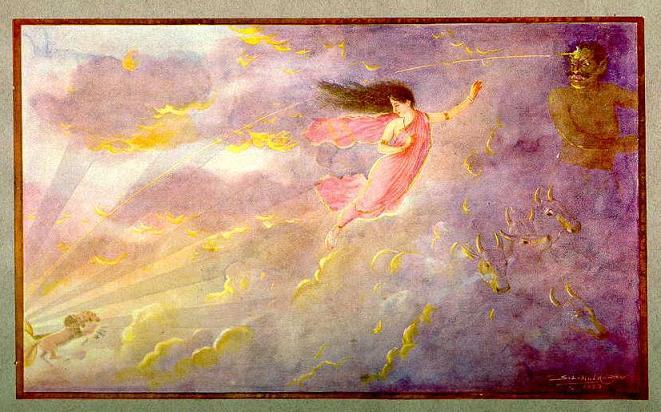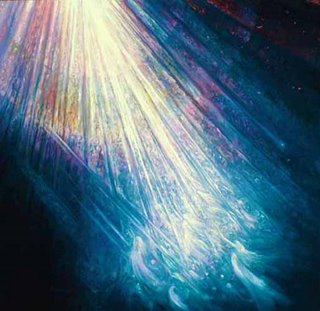The fear of the endless cycle of samsara as a result of the birth into this world was mentioned in my last post as a probable reason for the unfounded fear and discrimination against women. But it isn't the only reason - there are quite a few reasons that have contributed to this faulty perception. One of the more crucial factors is the practice called Brahmacharya (celibacy) followed by those seeking enlightenment and 'release' from this cycle of life and death.
To understand why this practice has contributed to the confused state of mind, it will be necessary to look into the theory behind the practice of celibacy or brahmacharya (quite briefly atleast). It is known that most things in this universe and in the human body exist in triads (sets of three) - like the 3 gunas (rajas,tamas and sattva), the 3 states (jagrat,swapna and sushupti), the 3 murthys (brahma,vishnu and siva), the 3 actions (creation,preservation and destruction), the 3 doshas (vata, pitta and kapha) etc. It is due to the fact of all things being in triads that the Devi in Her transcendental aspect is called Tripura or TripuraSundari.

Similarly, there exists another important triad in us - the triad formed by the Manas (mind), Prana (life force/breath) and Shukla (sperm/sexual fluids). This is a very important triad which has been discussed in great detail by many texts and sutras following in the path of Yoga. The objective of Yoga is to harmonize the alternating currents of consciousness, to rid the lake of the mind of the ripples of multiple and contrasting thought processes. The sutras describe that intuition or insight is that which is derived from meditation. They further say that the mind or manas is like a large lake whose waters are constantly overrun by the ripples that are caused by the various stimuli of this world. This 'lake' of the mind has to be stilled (made to be without those ripples) so that it becomes like a pure mirror, capable then of reflecting the pure consciousness that it is in proximity to (or is in the exact nature of). This is insight. This is the path of yoga, through which it is possible to overcome duality and achieve the 'perfect' body and mind - the path of becoming supernatural, pure transformation.
Having established that, we come to the next part. How then can this mind be stilled? We know that it is in the very nature of this mind to travel faster than light or sound, it is constantly agitated, always on the move, never still. This body can be kept in place by chains or by the iron bars of a cage or prison, but that is not so with respect to the mind. It has the capacity (which it delights in making such a show of) to be unbound in an instant. A smell here, a sound there and there you have it, its gone....following that or to a different place all of its own choice! So how is this mind to be stilled or bought under control? This is where we come to the triad (previously mentioned) - this manas (mind) is connected to Prana (breath) and to Shukla (sperm/sexual fluids). Thus if any one of these (of the triad) were bought under control it will lead to the control of the other two!! Amazing isn't it? It is, and it is very true too! If the sadhaka has the capacity to control the mind, he can control the prana and the shukla, likewise if he can control the prana he can control the shukla and the manas, and if can control the manas he can control the shukla and the prana.
The importance of this triad (of manas, prana and shukla) in terms of spiritual growth and enlightenment/liberation can also be seen in the Skanda guru kavacham in the following words -
'' இடகலை பிங்கலை ஏதும் அறிந்திலேன் நான்
இந்திரியம் அடக்கி இருந்தும் அறிகிலேன் நான்
மனதை அடக்க வழி ஒன்றும் அறிந்திலேன் நான் ''
Meaning - '' I know not the method to restrain the flow (of prana) in the ida and the pingala nadis (i.e. the process called pranayama). I know not the method to control the organs (organs of action and those of perception) or Indriya (i.e. the process through which the organs including those of generation are controlled, control of shukla). I know not any method to control/still the mind (i.e. the control or the stilling of manas/mind). '' The very three parts of the important triad that we have been discussing so far!
This is why the practice of Pranayama or the control and regulation of the breath is so important in the path of yoga. The yogi is attempting through the control of prana to gain control over the shukla and the manas (which is the object of yoga). But this is a difficult and a time consuming process (pranayama) to achieve the full siddhi in and hence is not possible by all. The process of the control of the mind (manas) itself directly proves impossible for the most of us (only a handful of jnayana yogis have succeeded) while we are still pushed and pulled by the everyday events. The control of the shukla or the sexual fluids however is not so - it is a process that can be attempted by quite a lot of people. Here I use the word 'control' instead of complete abstinence as that is a subject of further debate (in my mind anyway) and depends on the ashrama or the state of life of the sadhaka. Hence the practice of Brahmacharya or the vow of celibacy was advocated for those on the inward path. However it has to be borne in mind that at this stage it was a purely 'technical' process, alchemical more like and did NOT have any of the moral tones that it has ended up being dressed in today. This fact can be verified by the existence in the path of yoga, the process (most esoteric) called Vajroli. Great siddhas and many masters have practiced it, Siva the great yogi is the paragon of this type of yoga (note that Siva and Parvati are engaged in sexual intercourse that lasts for hundreds of years as there is no letting down of the shukla or sperm of Siva). From the process of vajroli and the Priyanka yoga (or the yoga of the cot) mentioned in Thirumoolars thirumandiram etc, it can be easily understood that there was no moral taboo against sex. There was merely the understanding of the energetics of the body and mind to great detail - The control of the sexual fluids is different from the control of the sexual energy- and the shukla was found to be the essence of all the other dhatus (as per ayurveda and its understanding of the seven dhatus). This is also hidden in the Sahasranama (where the names and the specific dhatus and the preferences of the 7 yoginis are mentioned) and shukla there too is the essence of the synthesis of all the other preceding dhatus. Thus the yogis advocated the preservation of this shukla and its subsequent transformation into light and its reabsorption into the body as pure amrta or nectar. The fluid of life is 'transformed' if you like alchemically and this transformation results not only in the control over the mind, but also in prolonged life, increased 'thejas' and 'ojas' etc. The body becomes disease free and the mind still. But in the other yugas, the individual life span was much longer and people were very disciplined (in terms of sticking to vows etc) and the same cant be said for our times.
At some point in the not too distant past (say two to three thousand years ago) it was becoming increasingly clear that the effects of Kaliyuga were making themselves manifest. There was a decrease in the adherence to dharma and as a result there was a down trend in matters related to hard discipline. Then it was obvious that the practice of brahmacharya or sexual abstinence was not possible by many (lack of discipline and control etc). It was perhaps at that crucial point in the evolution of the Hindu society, that the element of 'morality' was linked to sex and the practice of brahmacharya. If the people lacked internal discipline to persist in the control of shukla, the next step to enforce that control was by manipulating the emotional/guilt mechanism of the individual or society concerned. The main distraction for the men trying to achieve the end result of the practice of brahmacharya was their alltogether 'natural' urge for sexual intercourse. So, slowly but thoroughly the scriptures and their commentaries were 'painted' over with this moralistic attitude. Every passage in the shrutis were configured/interpreted to present a picture that equated the act of sex with filth, sin and other negative attitudes, the main idea being to turn men away from their more natural (and baser, granted) tendencies. Thus the woman, the object of desire, was presented as a 'deadly trap', a snare, something that once you got entangled with you were destined for endless lives in hell and inferior births. Up until that period in time, even though the practice of brahmacharya (by a select section of people in the right stage) was very much in vogue, the women were only held as Devi's themselves. They were respected, loved and enjoyed life in a position that was equal to the men(if not a superior position).

This 're writing' of the texts and the general attitude of moral censorship etc had to be supported by the so called vedic and puranic authority (for it to achieve mass acceptance) as the people of those times held the vedas as the highest pramana to settle any point. So, even the puranas themselves were 're written' and stories like Vishnu's delegating a part of the karma/sin committed by Indra to women, the argument that women as a result of their operating in the realms of emotion were not suitable for the process of self inquiry and other such practices that were more 'heady', etc were introduced. This change in the tone of the puranas is also quite interesting and I will elaborate on that with a story from the puranas in my next post on this same subject.
In finishing up this post, I should add - If one is unable to see the Devi in one's mother, sister, wife, daughter, friend or any other woman in this world and respect and treat them with love, there is no way for that someone to see the Devi(Lalitha) or be called a devotee of the goddess or a shakta. Personally, I believe there is no way for them to even be called 'human'. The Devi Herself has said, I exist in the form of all women and all things feminine - what more do I need say?
या देवी सर्वभूतेषु मात्रु रूपेन संस्तिथा ।
नमस्तस्यै नमस्तस्यै नमस्तस्यै नमो नमः ॥

